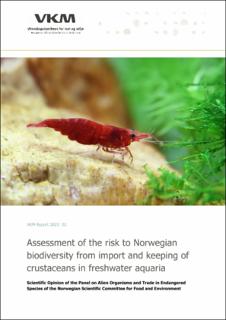| dc.description.abstract | Key words: Risk assessment, Crayfish, Shrimps, Crabs, Climate change, Aphanomyces astaci, White spot syndrome, Alien species, Biological invasion Introduction The Norwegian Scientific Committee for Food and Environment (VKM) was requested by the Norwegian Environment Agency to assess the risk of negative impacts to biodiversity in Norway resulting from import of crustacean decapods for keeping in freshwater aquariums. VKM was asked to 1) list species of crayfish, crabs and shrimps that are currently kept in freshwater aquaria in Norway, and species that are likely to be kept in freshwater aquaria in Norway within the next 10 years, 2) assess the ability of the species to survive under Norwegian conditions and cause impacts on ecosystems and other species, and 3) state the potential negative effects on the biological diversity of diseases caused by pathogens, regulated under the Norwegian Food Act. Methods The risk assessment, without focus on pathogens, was performed in two steps. First, we used a pre-screening toolkit to identify species of crayfish, crabs and shrimps with potential to become invasive in freshwater habitats in Norway. Each species was given an invasiveness score based on 55 questions on biogeography, ecology, and climate change. In a second step, a full risk assessment, including the potential impacts of pathogens, was conducted on those species receiving the highest invasiveness score. This assessment included questions on the organism’s probability of entry and pathways of entry, establishment and spread, potential impacts on biodiversity, and how climate change scenarios might affect the assessment. Likelyhood and confidence was assessed for each question. In conclusion, each species was designated as either low-, moderate-, or high risk. Many crustacean decapod species are confirmed or suspected carriers of pathogens that can cause mass mortality among native crustaceans. The risk posed by crustaceans as carriers of pathogens may be independent of the environmental risk that they pose through ecological interactions. Therefore, the four crustacean disease pathogens that are regulated under the Norwegian Food Act, were assessed separately. These include Aphanomyces astaci causing crayfish plague, white spot syndrome virus (WSSV) causing white spot disease, Taura syndrome virus (TSV) causing Taura syndrome, and yellow head virus genotype 1 (YHV1) causing yellow head disease. The assessments comprised questions on the pathogen’s probability of entry (as a hitchhiker organism with imported crustaceans), pathways of entry, establishment and spread, and potential impact on crustacean biodiversity. Likelihood and confidence were assessed for each question. In conclusion, each pathogen was designated as either low-, moderate-, or high risk. In a third step, we categorized the likelihood that a crustacean species introduces a pathogen associated with a high- or moderate risk into: I) known chronic carriers, II) suspected chronic carriers, III) suspected situational carrier, IV) possible pathogen transmitters, and V) no direct or circumstantial evidence for carrier status or pathogen transmission in the genus. Results Based on information from the Norwegian Pet Trade Association, the project group listed 112 taxa (mainly species and some genera) of freshwater crayfish, crabs and shrimps that are relevant for trade in Norway. These included 38 crayfish taxa, 28 crab taxa, and 45 shrimp taxa. In addition, one marine crab was included. Sixteen species of crayfish, four species of shrimps, and two species of crabs underwent a full ecological risk assessment. The probabilities of entry both into the aquarium trade in Norway, and potentially further into Norwegian nature, were based on the prevalence of the species in the aquarium trade in Norway. We assumed that all species were equally likely to escape captivity or to be ......... | |
